light MAZDA MODEL 3 HATCHBACK 2020 (in English) User Guide
[x] Cancel search | Manufacturer: MAZDA, Model Year: 2020, Model line: MODEL 3 HATCHBACK, Model: MAZDA MODEL 3 HATCHBACK 2020Pages: 598, PDF Size: 89.37 MB
Page 36 of 598
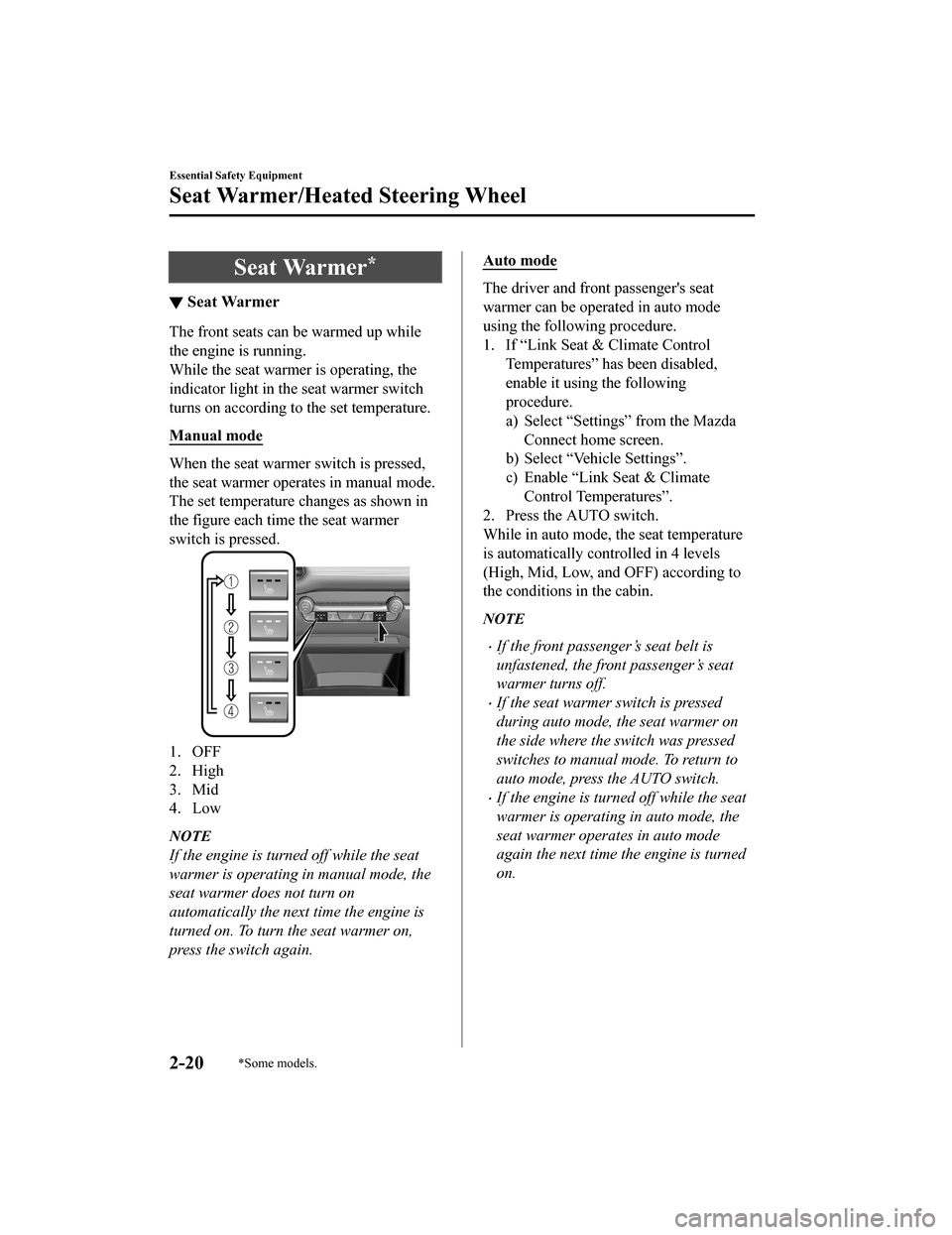
Seat Warmer*
▼Seat Warmer
The front seats can be warmed up while
the engine is running.
While the seat warme
r is operating, the
indicator light in the seat warmer switch
turns on according to t he set temperature.
Manual mode
When the seat warmer switch is pressed,
the seat warmer operates in manual mode.
The set temperature changes as shown in
the figure each time the seat warmer
switch is pressed.
1. OFF
2. High
3. Mid
4. Low
NOTE
If the engine is turned off while the seat
warmer is operating in manual mode, the
seat warmer does not turn on
automatically the next time the engine is
turned on. To turn the seat warmer on,
press the switch again.
Auto mode
The driver and front passenger's seat
warmer can be operated in auto mode
using the following procedure.
1. If “Link Seat & Climate Control Temperatures” has been disabled,
enable it using the following
procedure.
a) Select “Settings” from the MazdaConnect home screen.
b) Select “Vehicle Settings”.
c) Enable “Link Seat & Climate Control Temperatures”.
2. Press the AUTO switch.
While in auto mode, th e seat temperature
is automatically controlled in 4 levels
(High, Mid, Low, and OFF) according to
the conditions in the cabin.
NOTE
If the front passenger’s seat belt is
unfastened, the front passenger’s seat
warmer turns off.
If the seat warmer switch is pressed
during auto mode, the seat warmer on
the side where the switch was pressed
switches to manual mode. To return to
auto mode, press the AUTO switch.
If the engine is turned off while the seat
warmer is operating in auto mode, the
seat warmer operates in auto mode
again the next time the engine is turned
on.
Essential Safety Equipment
Seat Warmer/Heated Steering Wheel
2-20*Some models.
Mazda3_8HZ1-EA-19G_Edition1_old 2019-5-17 13:49:03
Page 37 of 598
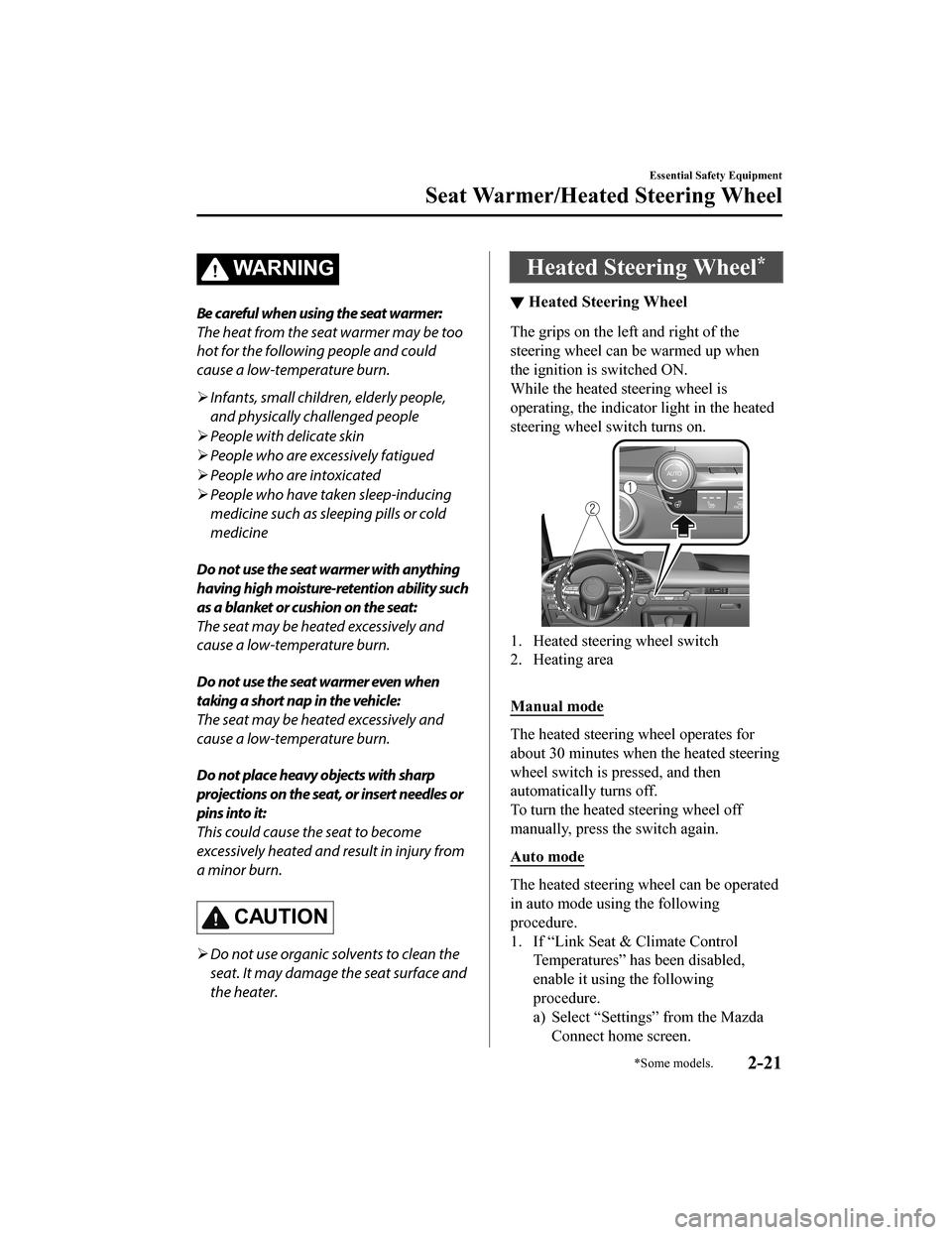
WA R N I N G
Be careful when using the seat warmer:
The heat from the seat warmer may be too
hot for the following people and could
cause a low-temperature burn.
Infants, small children, elderly people,
and physically challenged people
People with delicate skin
People who are excessively fatigued
People who are intoxicated
People who have taken sleep-inducing
medicine such as sleeping pills or cold
medicine
Do not use the seat warmer with anything
having high moisture-retention ability such
as a blanket or cushion on the seat:
The seat may be heated excessively and
cause a low-temperature burn.
Do not use the seat warmer even when
taking a short nap in the vehicle:
The seat may be heated excessively and
cause a low-temperature burn.
Do not place heavy objects with sharp
projections on the seat, or insert needles or
pins into it:
This could cause the seat to become
excessively heated and result in injury from
a minor burn.
CAUTION
Do not use organic solvents to clean the
seat. It may damage the seat surface and
the heater.
Heated Steering Wheel*
▼ Heated Steering Wheel
The grips on the left and right of the
steering wheel can be warmed up when
the ignition is switched ON.
While the heated steering wheel is
operating, the indicator light in the heated
steering wheel sw
itch turns on.
1. Heated steering wheel switch
2. Heating area
Manual mode
The heated steering wheel operates for
about 30 minutes when the heated steering
wheel switch is pressed, and then
automatically turns off.
To turn the heated steering wheel off
manually, press the switch again.
Auto mode
The heated steering wheel can be operated
in auto mode using the following
procedure.
1. If “Link Seat & Climate Control
Temperatures” has been disabled,
enable it using the following
procedure.
a) Select “Settings” from the Mazda
Connect home screen.
Essential Safety Equipment
Seat Warmer/Heated Steering Wheel
*Some models.2-21
Mazda3_8HZ1-EA-19G_Edition1_old 2019-5-17 13:49:03
Page 43 of 598
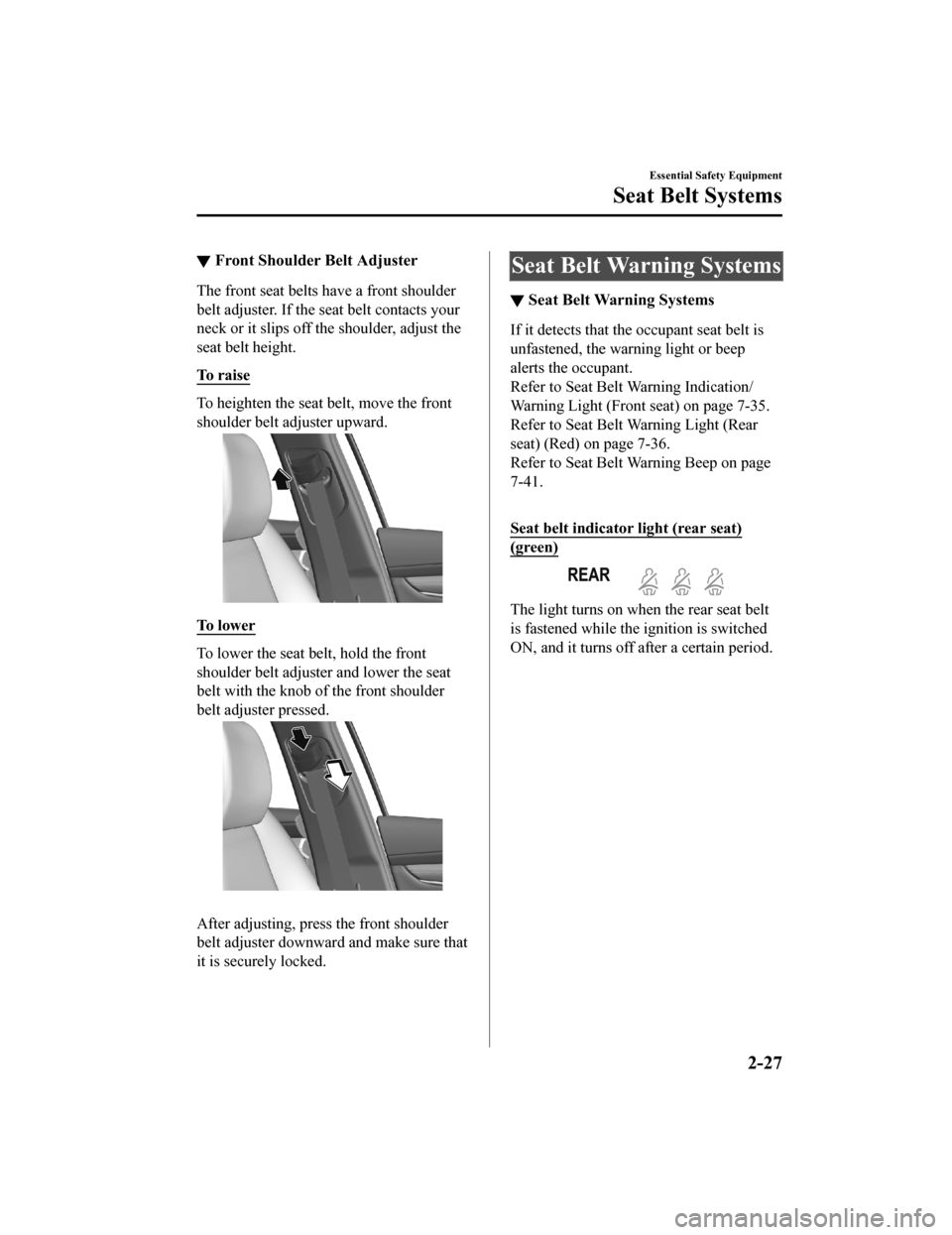
▼Front Shoulder Belt Adjuster
The front seat belts
have a front shoulder
belt adjuster. If the seat belt contacts your
neck or it slips off the shoulder, adjust the
seat belt height.
To r a i s e
To heighten the seat belt, move the front
shoulder belt adjuster upward.
To l o w e r
To lower the seat belt, hold the front
shoulder belt adjuster and lower the seat
belt with the knob of the front shoulder
belt adjuster pressed.
After adjusting, press the front shoulder
belt adjuster downward and make sure that
it is securely locked.
Seat Belt Warning Systems
▼ Seat Belt Warning Systems
If it detects that the occupant seat belt is
unfastened, the warning light or beep
alerts the occupant.
Refer to Seat Belt Wa
rning Indication/
Warning Light (Front seat) on page 7-35.
Refer to Seat Belt Warning Light (Rear
seat) (Red) on page 7-36.
Refer to Seat Belt Wa rning Beep on page
7-41.
Seat belt indicator light (rear seat)
(green)
The light turns on when the rear seat belt
is fastened while the ignition is switched
ON, and it turns off after a certain period.
Essential Safety Equipment
Seat Belt Systems
2-27
Mazda3_8HZ1-EA-19G_Edition1_old 2019-5-17 13:49:03
Page 44 of 598
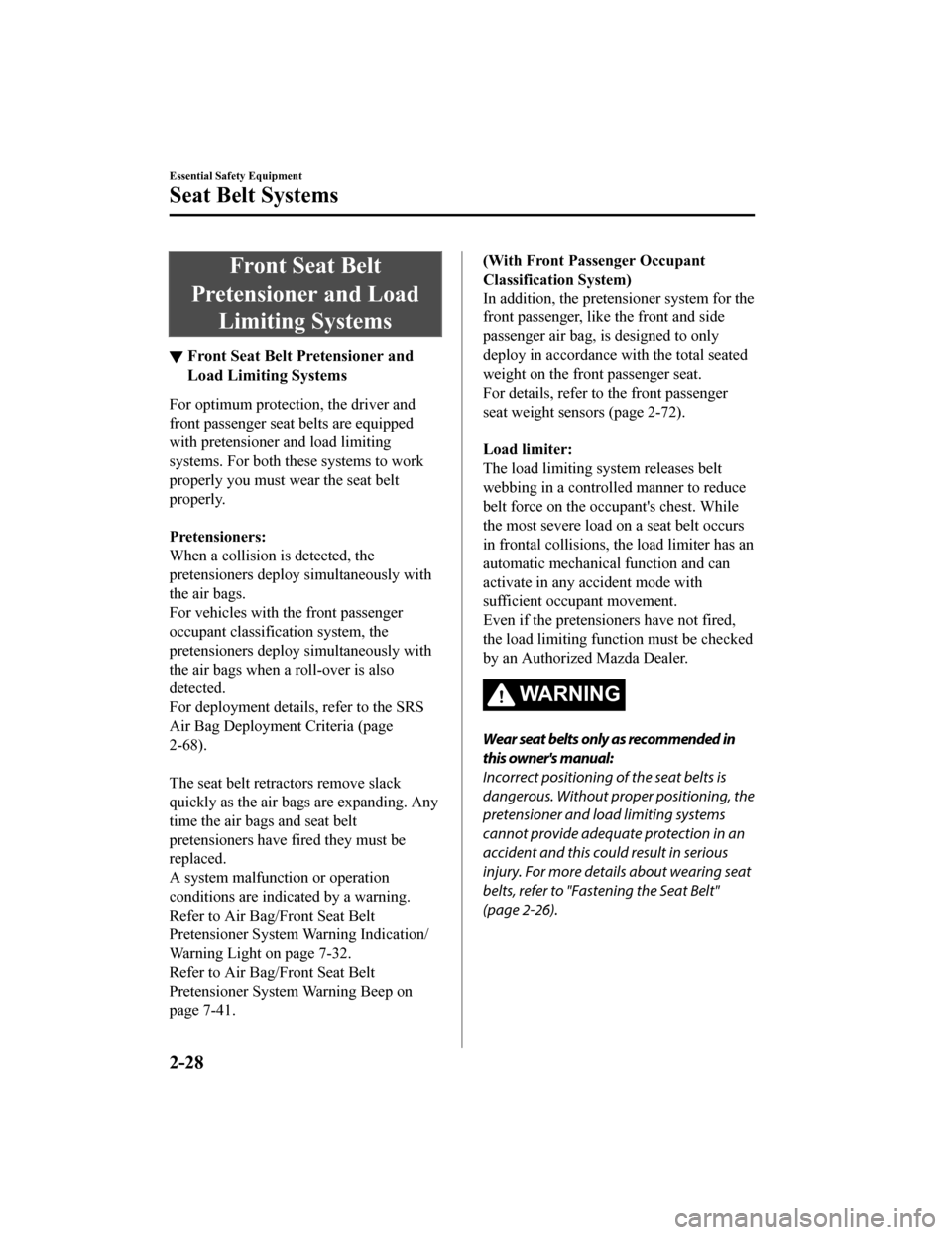
Front Seat Belt
Pretensioner and Load Limiting Systems
▼Front Seat Belt
Pretensioner and
Load Limiting Systems
For optimum protection, the driver and
front passenger seat belts are equipped
with pretensioner and load limiting
systems. For both these systems to work
properly you must wear the seat belt
properly.
Pretensioners:
When a collision is detected, the
pretensioners deploy simultaneously with
the air bags.
For vehicles with t he front passenger
occupant classification system, the
pretensioners deploy simultaneously with
the air bags when a roll-over is also
detected.
For deployment details, refer to the SRS
Air Bag Deployment Criteria (page
2-68).
The seat belt retractors remove slack
quickly as the air bags are expanding. Any
time the air bags and seat belt
pretensioners have fired they must be
replaced.
A system malfunction or operation
conditions are indicated by a warning.
Refer to Air Bag/Front Seat Belt
Pretensioner System Warning Indication/
Warning Light on page 7-32.
Refer to Air Bag/Front Seat Belt
Pretensioner System Warning Beep on
page 7-41.
(With Front Passenger Occupant
Classification System)
In addition, the pretensioner system for the
front passenger, like the front and side
passenger air bag, is designed to only
deploy in accordance with the total seated
weight on the front passenger seat.
For details, refer to the front passenger
seat weight sensors (page 2-72).
Load limiter:
The load limiting system releases belt
webbing in a controlled manner to reduce
belt force on the occupant's chest. While
the most severe load on a seat belt occurs
in frontal collisions, th e load limiter has an
automatic mechanical function and can
activate in any accident mode with
sufficient occupant movement.
Even if the pretensioners have not fired,
the load limiting function must be checked
by an Authorized Mazda Dealer.
WA R N I N G
Wear seat belts only as recommended in
this owner's manual:
Incorrect positioning of the seat belts is
dangerous. Without pr oper positioning, the
pretensioner and load limiting systems
cannot provide adequate protection in an
accident and this could result in serious
injury. For more deta ils about wearing seat
belts, refer to "Fastening the Seat Belt"
(page 2-26).
Essential Safety Equipment
Seat Belt Systems
2-28
Mazda3_8HZ1-EA-19G_Edition1_old 2019-5-17 13:49:03
Page 45 of 598
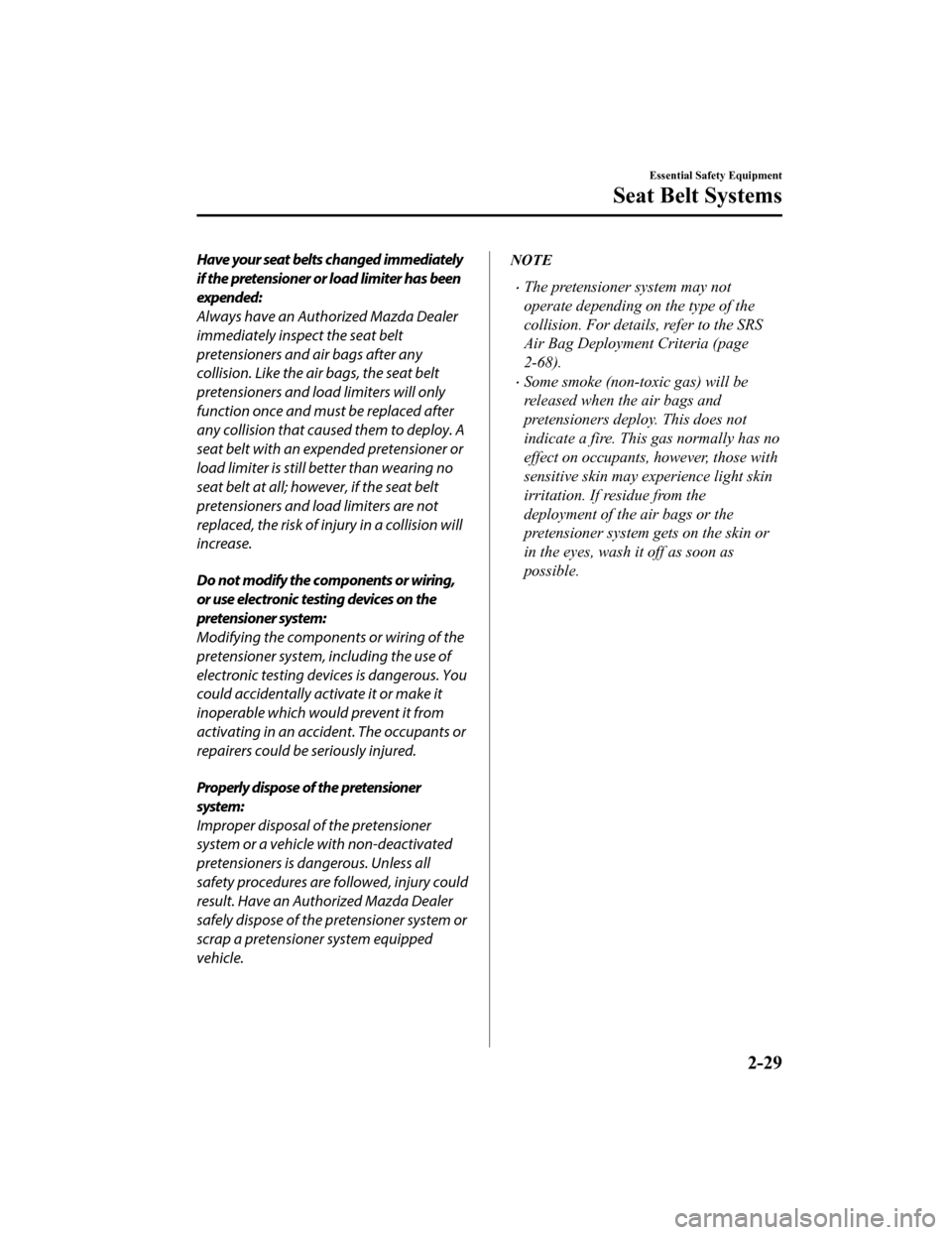
Have your seat belts changed immediately
if the pretensioner or load limiter has been
expended:
Always have an Authorized Mazda Dealer
immediately inspect the seat belt
pretensioners and air bags after any
collision. Like the air bags, the seat belt
pretensioners and load limiters will only
function once and must be replaced after
any collision that caused them to deploy. A
seat belt with an expended pretensioner or
load limiter is still better than wearing no
seat belt at all; however, if the seat belt
pretensioners and load limiters are not
replaced, the risk of injury in a collision will
increase.
Do not modify the components or wiring,
or use electronic testing devices on the
pretensioner system:
Modifying the components or wiring of the
pretensioner system, including the use of
electronic testing devices is dangerous. You
could accidentally activate it or make it
inoperable which would prevent it from
activating in an accident. The occupants or
repairers could be seriously injured.
Properly dispose of the pretensioner
system:
Improper disposal of the pretensioner
system or a vehicle with non-deactivated
pretensioners is dangerous. Unless all
safety procedures are followed, injury could
result. Have an Authorized Mazda Dealer
safely dispose of the pretensioner system or
scrap a pretensioner system equipped
vehicle.NOTE
The pretensioner system may not
operate depending on the type of the
collision. For details, refer to the SRS
Air Bag Deployment Criteria (page
2-68).
Some smoke (non-toxic gas) will be
released when the air bags and
pretensioners deploy. This does not
indicate a fire. This gas normally has no
effect on occupants, however, those with
sensitive skin may experience light skin
irritation. If residue from the
deployment of the air bags or the
pretensioner system gets on the skin or
in the eyes, wash it off as soon as
possible.
Essential Safety Equipment
Seat Belt Systems
2-29
Mazda3_8HZ1-EA-19G_Edition1_old 2019-5-17 13:49:03
Page 47 of 598
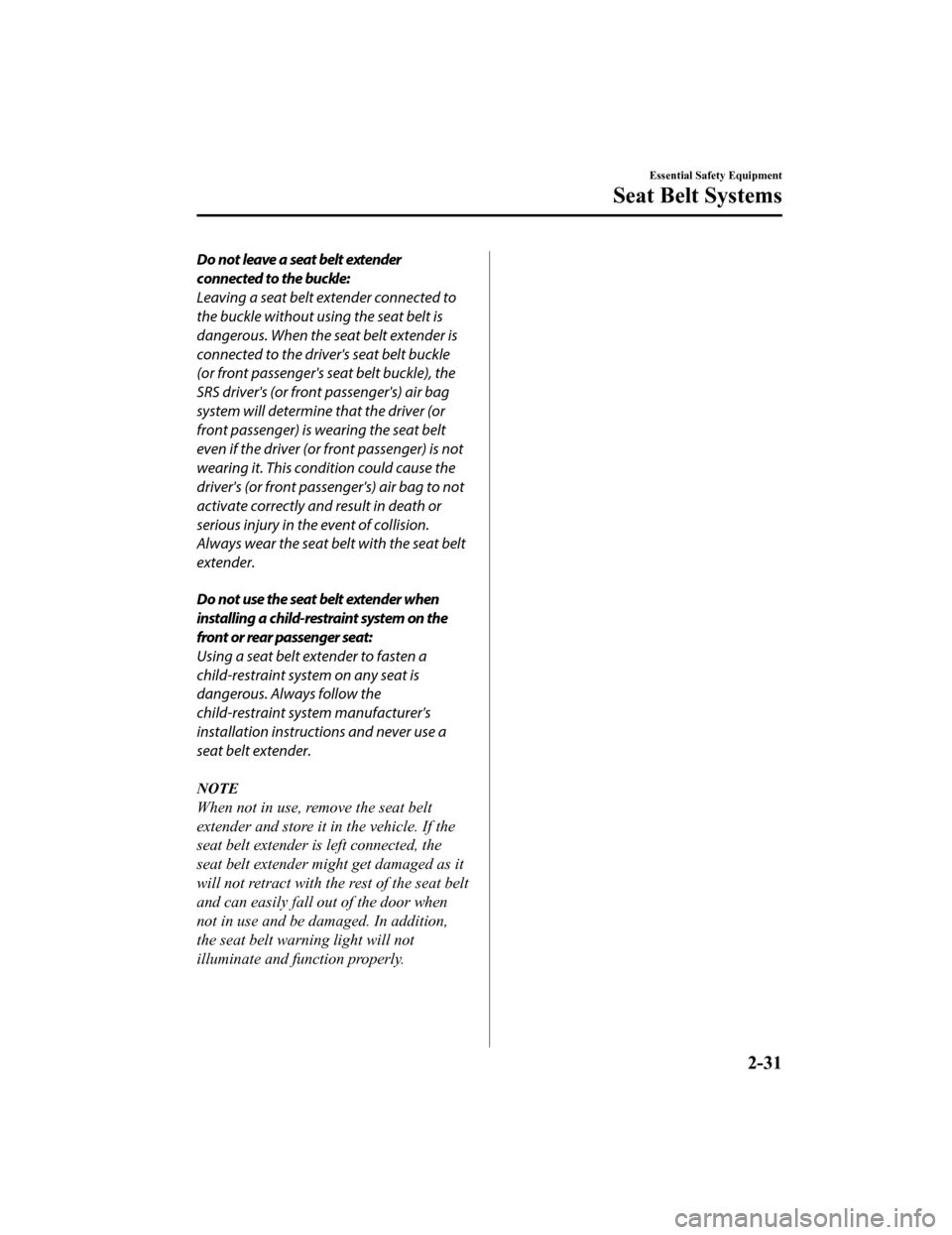
Do not leave a seat belt extender
connected to the buckle:
Leaving a seat belt extender connected to
the buckle without using the seat belt is
dangerous. When the seat belt extender is
connected to the driver's seat belt buckle
(or front passenger's seat belt buckle), the
SRS driver's (or front passenger's) air bag
system will determine that the driver (or
front passenger) is wearing the seat belt
even if the driver (or front passenger) is not
wearing it. This condition could cause the
driver's (or front passenger's) air bag to not
activate correctly and result in death or
serious injury in the event of collision.
Always wear the seat belt with the seat belt
extender.
Do not use the seat belt extender when
installing a child-restraint system on the
front or rear passenger seat:
Using a seat belt extender to fasten a
child-restraint system on any seat is
dangerous. Always follow the
child-restraint system manufacturer's
installation instructions and never use a
seat belt extender.
NOTE
When not in use, remove the seat belt
extender and store it in the vehicle. If the
seat belt extender is left connected, the
seat belt extender might get damaged as it
will not retract with the rest of the seat belt
and can easily fall out of the door when
not in use and be damaged. In addition,
the seat belt warning light will not
illuminate and function properly.
Essential Safety Equipment
Seat Belt Systems
2-31
Mazda3_8HZ1-EA-19G_Edition1_old2019-5-17 13:49:03
Page 48 of 598
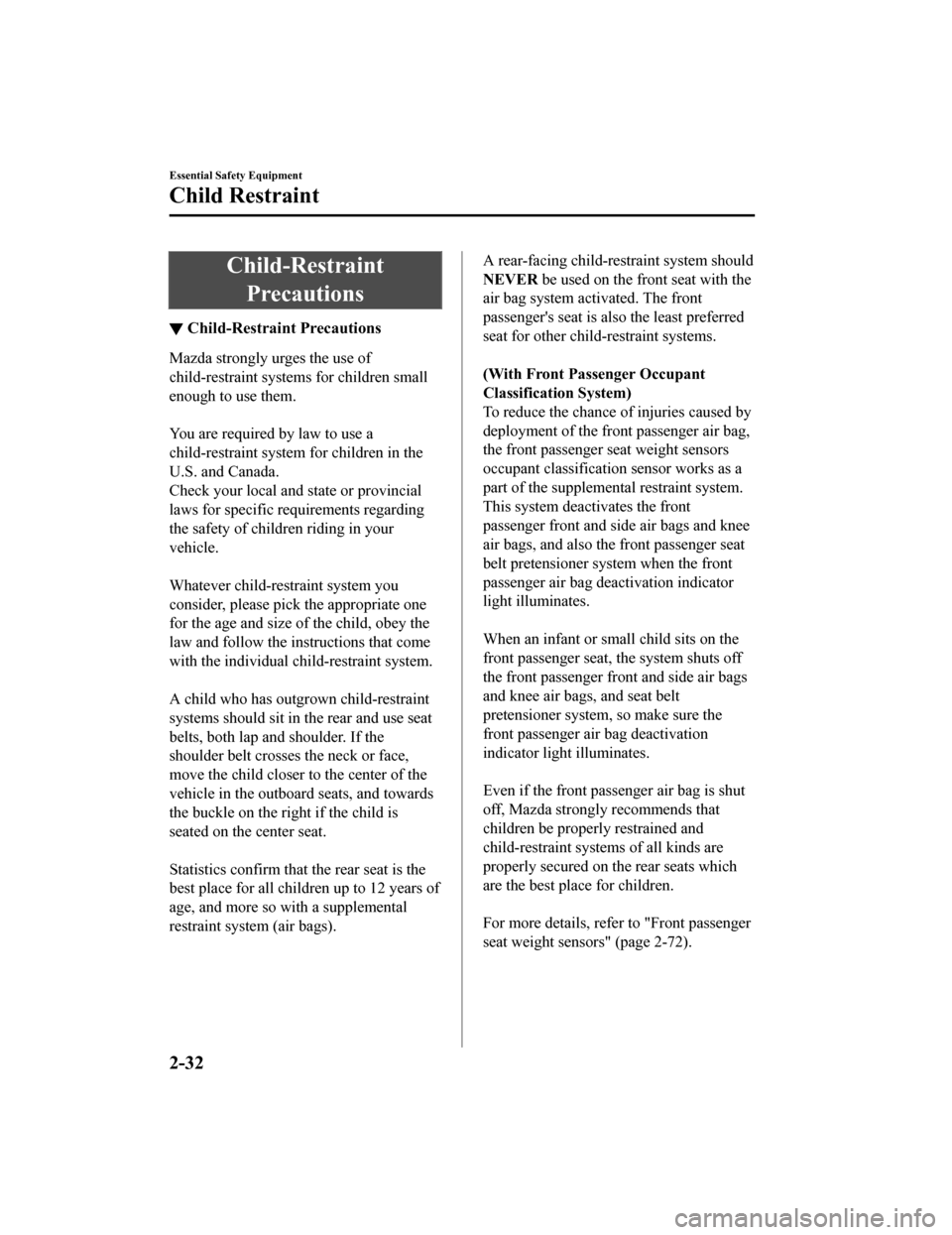
Child-RestraintPrecautions
▼ Child-Restraint Precautions
Mazda strongly urges the use of
child-restraint system
s for children small
enough to use them.
You are required by law to use a
child-restraint system for children in the
U.S. and Canada.
Check your local and state or provincial
laws for specific requirements regarding
the safety of childr en riding in your
vehicle.
Whatever child-rest raint system you
consider, please pick the appropriate one
for the age and size of the child, obey the
law and follow the i nstructions that come
with the individual ch ild-restraint system.
A child who has outgrown child-restraint
systems should sit in the rear and use seat
belts, both lap an d shoulder. If the
shoulder belt crosses the neck or face,
move the child closer to the center of the
vehicle in the outboard seats, and towards
the buckle on the right if the child is
seated on the center seat.
Statistics confirm that the rear seat is the
best place for all children up to 12 years of
age, and more so with a supplemental
restraint system (air bags).
A rear-facing child-restraint system should
NEVER be used on the front seat with the
air bag system activated. The front
passenger's seat is also the least preferred
seat for other child-restraint systems.
(With Front Passenger Occupant
Classification System)
To reduce the chance of injuries caused by
deployment of the front passenger air bag,
the front passenger seat weight sensors
occupant classification sensor works as a
part of the supplementa l restraint system.
This system deactivates the front
passenger front and side air bags and knee
air bags, and also the front passenger seat
belt pretensioner system when the front
passenger air bag deactivation indicator
light illuminates.
When an infant or small child sits on the
front passenger seat, the system shuts off
the front passenger front and side air bags
and knee air bags, and seat belt
pretensioner system, so make sure the
front passenger air bag deactivation
indicator light illuminates.
Even if the front passenger air bag is shut
off, Mazda strongly recommends that
children be prope rly restrained and
child-restraint systems of all kinds are
properly secured on the rear seats which
are the best place for children.
For more details, refer to "Front passenger
seat weight sensors" (page 2-72).
Essential Safety Equipment
Child Restraint
2-32
Mazda3_8HZ1-EA-19G_Edition1_old 2019-5-17 13:49:03
Page 49 of 598
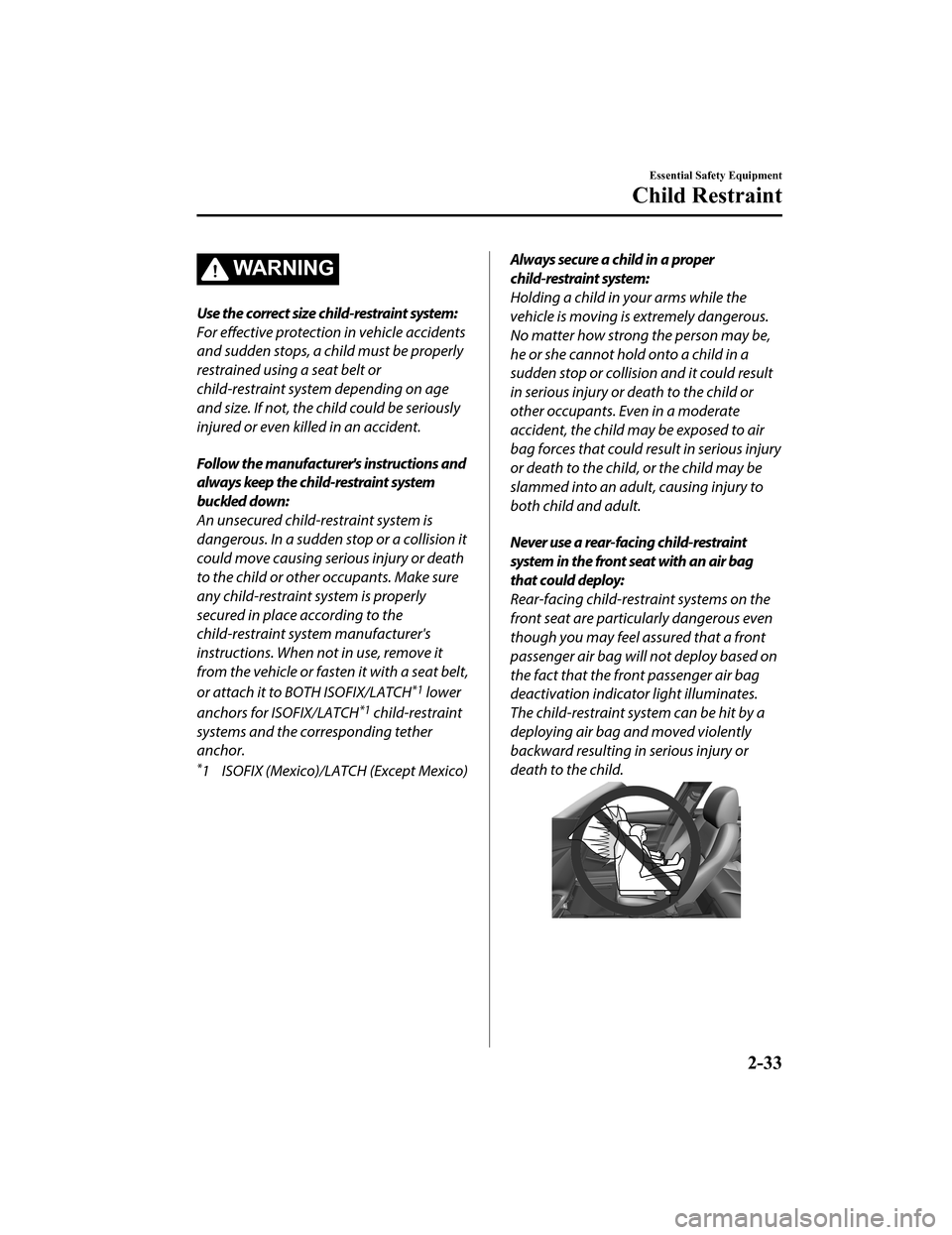
WA R N I N G
Use the correct size child-restraint system:
For effective protection in vehicle accidents
and sudden stops, a child must be properly
restrained using a seat belt or
child-restraint system depending on age
and size. If not, the child could be seriously
injured or even killed in an accident.
Follow the manufacturer's instructions and
always keep the child-restraint system
buckled down:
An unsecured child-restraint system is
dangerous. In a sudden stop or a collision it
could move causing serious injury or death
to the child or other occupants. Make sure
any child-restraint system is properly
secured in place according to the
child-restraint system manufacturer's
instructions. When not in use, remove it
from the vehicle or fasten it with a seat belt,
or attach it to BOTH ISOFIX/LATCH
*1 lower
anchors for ISOFIX/LATCH
*1 child-restraint
systems and the corresponding tether
anchor.
*1 ISOFIX (Mexico)/LATCH (Except Mexico)
Always secure a child in a proper
child-restraint system:
Holding a child in your arms while the
vehicle is moving is extremely dangerous.
No matter how strong the person may be,
he or she cannot hold onto a child in a
sudden stop or collision and it could result
in serious injury or death to the child or
other occupants. Even in a moderate
accident, the child may be exposed to air
bag forces that could result in serious injury
or death to the child, or the child may be
slammed into an adult, causing injury to
both child and adult.
Never use a rear-facing child-restraint
system in the front seat with an air bag
that could deploy:
Rear-facing child-restraint systems on the
front seat are particularly dangerous even
though you may feel assured that a front
passenger air bag will not deploy based on
the fact that the front passenger air bag
deactivation indicator light illuminates.
The child-restraint system can be hit by a
deploying air bag and moved violently
backward resulting in serious injury or
death to the child.
Essential Safety Equipment
Child Restraint
2-33
Mazda3_8HZ1-EA-19G_Edition1_old 2019-5-17 13:49:03
Page 50 of 598
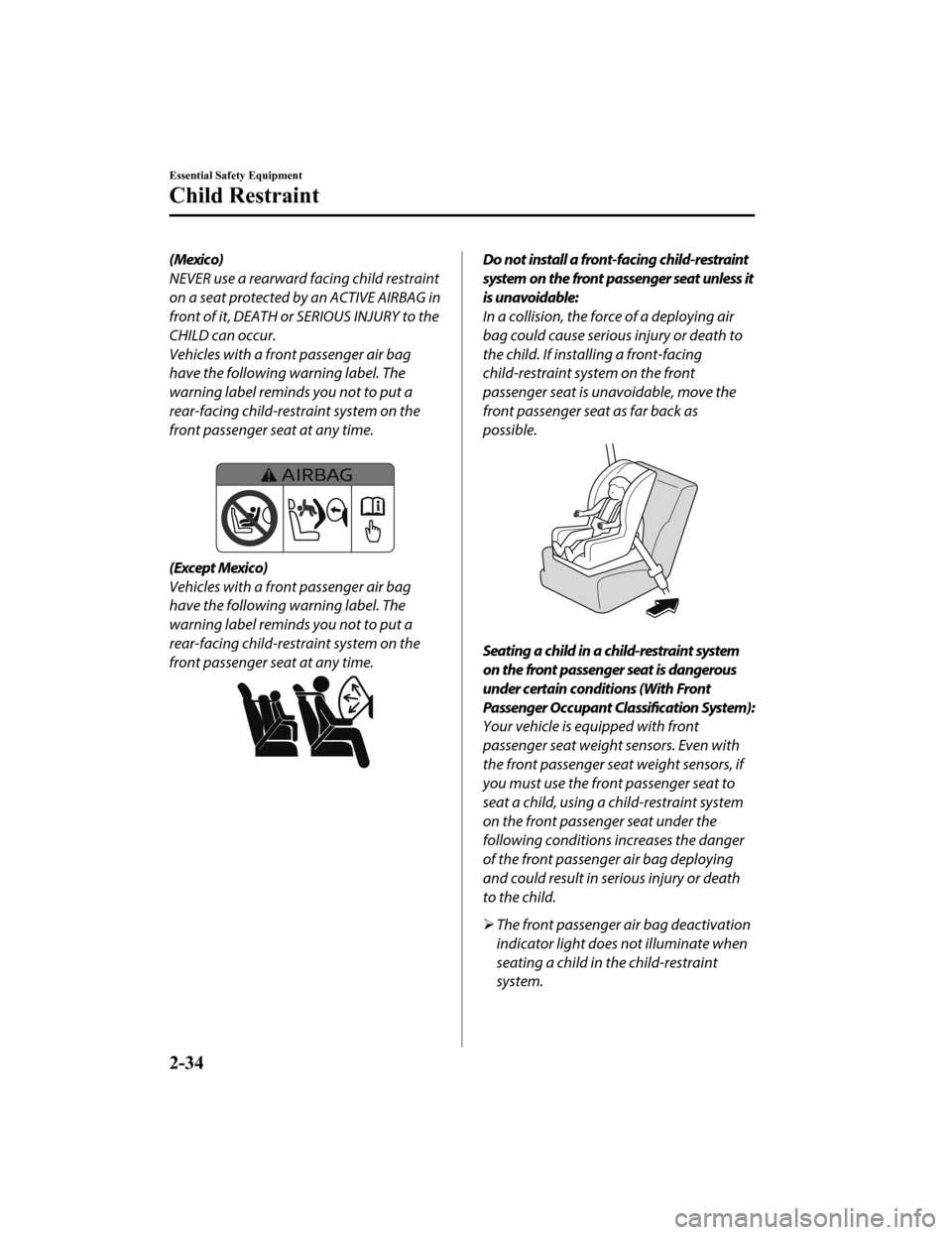
(Mexico)
NEVER use a rearward facing child restraint
on a seat protected by an ACTIVE AIRBAG in
front of it, DEATH or SERIOUS INJURY to the
CHILD can occur.
Vehicles with a front passenger air bag
have the following warning label. The
warning label reminds you not to put a
rear-facing child-restraint system on the
front passenger seat at any time.
(Except Mexico)
Vehicles with a front passenger air bag
have the following warning label. The
warning label reminds you not to put a
rear-facing child-restraint system on the
front passenger seat at any time.
Do not install a front-facing child-restraint
system on the front passenger seat unless it
is unavoidable:
In a collision, the force of a deploying air
bag could cause serious injury or death to
the child. If installing a front-facing
child-restraint system on the front
passenger seat is unavoidable, move the
front passenger seat as far back as
possible.
Seating a child in a child-restraint system
on the front passenger seat is dangerous
under certain conditions (With Front
Passenger Occupant Classification System):
Your vehicle is equipped with front
passenger seat weight sensors. Even with
the front passenger seat weight sensors, if
you must use the front passenger seat to
seat a child, using a child-restraint system
on the front passenger seat under the
following conditions increases the danger
of the front passenger air bag deploying
and could result in serious injury or death
to the child.
The front passenger air bag deactivation
indicator light does not illuminate when
seating a child in the child-restraint
system.
Essential Safety Equipment
Child Restraint
2-34
Mazda3_8HZ1-EA-19G_Edition1_old 2019-5-17 13:49:03
Page 63 of 598
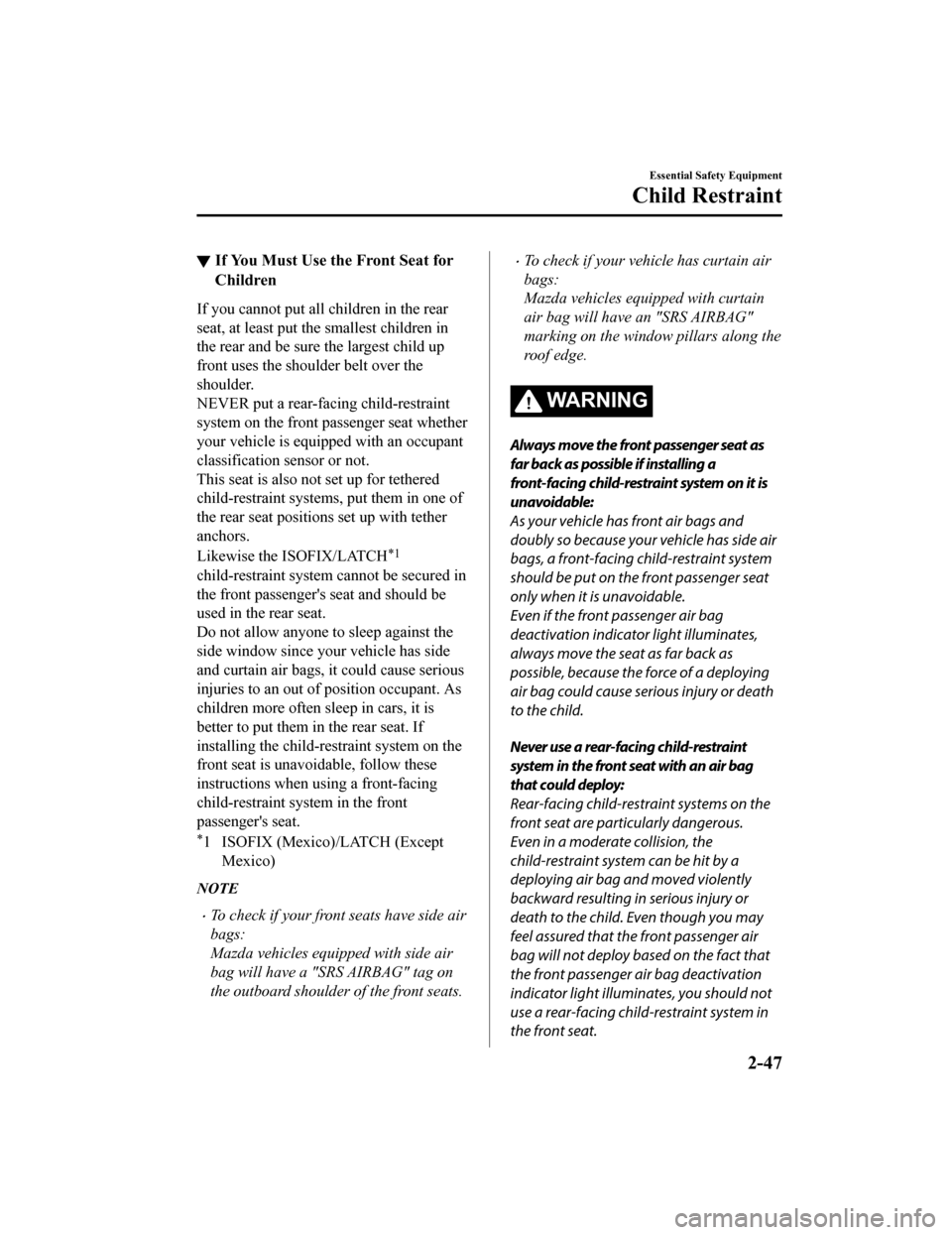
▼If You Must Use th
e Front Seat for
Children
If you cannot put all children in the rear
seat, at least put the smallest children in
the rear and be sure the largest child up
front uses the shou lder belt over the
shoulder.
NEVER put a rear-fac ing child-restraint
system on the front passenger seat whether
your vehicle is equipped with an occupant
classification sensor or not.
This seat is also not set up for tethered
child-restraint systems, put them in one of
the rear seat positions set up with tether
anchors.
Likewise the ISOFIX/LATCH
*1
child-restraint system cannot be secured in
the front passenger's seat and should be
used in the rear seat.
Do not allow anyone to sleep against the
side window since your vehicle has side
and curtain air bags, it could cause serious
injuries to an out of position occupant. As
children more often sleep in cars, it is
better to put them in the rear seat. If
installing the child-restraint system on the
front seat is unavoidable, follow these
instructions when using a front-facing
child-restraint system in the front
passenger's seat.
*1 ISOFIX (Mexico)/LATCH (Except Mexico)
NOTE
To check if your front seats have side air
bags:
Mazda vehicles equipped with side air
bag will have a "SRS AIRBAG" tag on
the outboard shoulder of the front seats.
To check if your vehicle has curtain air
bags:
Mazda vehicles equipped with curtain
air bag will have an "SRS AIRBAG"
marking on the window pillars along the
roof edge.
WA R N I N G
Always move the front passenger seat as
far back as possible if installing a
front-facing child-restraint system on it is
unavoidable:
As your vehicle has front air bags and
doubly so because your vehicle has side air
bags, a front-facing child-restraint system
should be put on the front passenger seat
only when it is unavoidable.
Even if the front passenger air bag
deactivation indicator light illuminates,
always move the seat as far back as
possible, because the force of a deploying
air bag could cause serious injury or death
to the child.
Never use a rear-facing child-restraint
system in the front seat with an air bag
that could deploy:
Rear-facing child-restraint systems on the
front seat are particularly dangerous.
Even in a moderate collision, the
child-restraint system can be hit by a
deploying air bag and moved violently
backward resulting in serious injury or
death to the child. Even though you may
feel assured that the front passenger air
bag will not deploy based on the fact that
the front passenger air bag deactivation
indicator light illuminates, you should not
use a rear-facing child-restraint system in
the front seat.
Essential Safety Equipment
Child Restraint
2-47
Mazda3_8HZ1-EA-19G_Edition1_old 2019-5-17 13:49:03